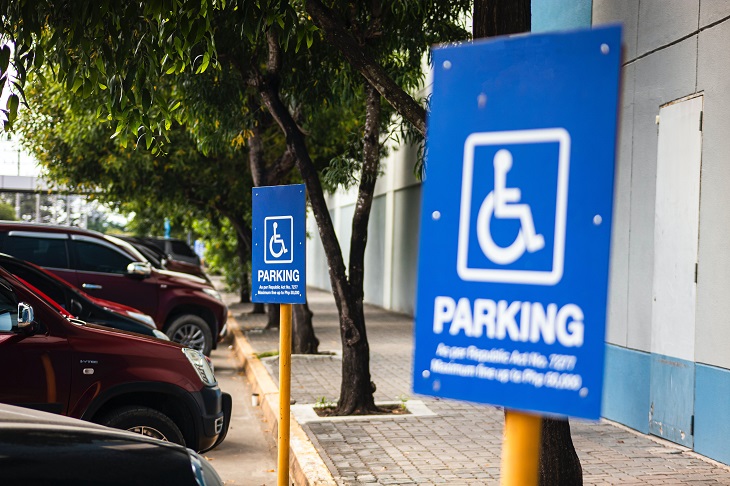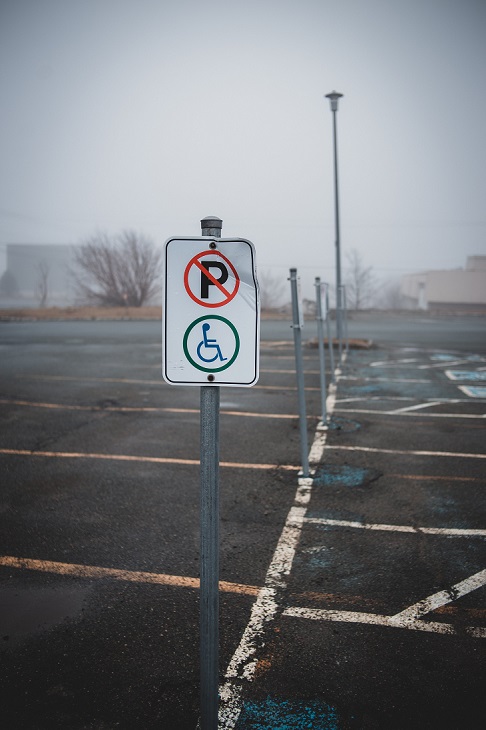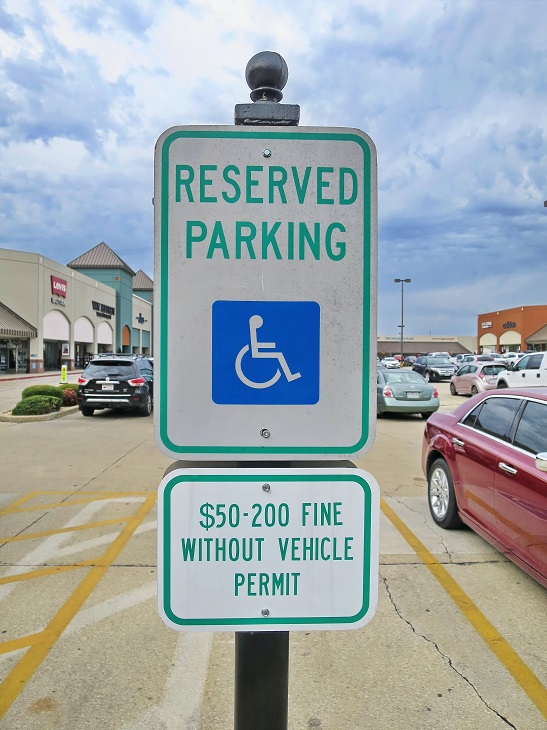In the vast landscape of consumerism that defines the United States, retail centers play a crucial role in shaping the shopping experience for millions of Americans. However, for a significant portion of the population with disabilities, the accessibility of these centers becomes a paramount concern. Handicap parking spaces, a key element of accessibility, are intended to provide convenience and ease of access for individuals with mobility challenges.
Today, we’re delving into the state of handicap parking at US retail centers, examining the current landscape, the challenges faced, and potential avenues for improvement. From Florida handicap parking laws in shopping malls to Washington State disabled parking requirements, we’ll cover the ins and outs of accessible parking across retail centers throughout the United States!
The Regulatory Framework
The foundation for handicap parking provisions in the United States is laid out by the Americans with Disabilities Act (ADA). The ADA provides comprehensive guidelines to ensure accessibility for individuals with disabilities, including specific provisions related to accessible parking in retail centers. ADA guidelines govern everything from Arizona handicap parking space dimensions to North Carolina handicap parking sign specifications to the Michigan handicap parking fine amount for accessible parking misuse.
Here’s an overview of the key guidelines outlined by the ADA:
- Number of Accessible Spaces: The ADA mandates that a certain percentage of parking spaces in retail centers must be designated as accessible. The exact number is determined by the total number of parking spaces provided by the facility. Generally, one in every six accessible spaces must be van-accessible, featuring additional space to accommodate wheelchair ramps.
- Location and Proximity: Accessible parking spaces must be located as close as possible to the facility’s entrance. Van-accessible spaces should have an adjacent access aisle to facilitate the deployment of ramps. The ADA specifies the maximum distance allowed between accessible parking spaces and the entrance, ensuring individuals with disabilities have convenient access.
- Signage and Markings: Accessible parking spaces must be clearly marked with the International Symbol of Accessibility. Additionally, the ground or surface of the parking space and access aisle should be level, firm, and slip-resistant. Proper signage is crucial for easy identification of these spaces.
- Dimensions of Accessible Spaces: ADA guidelines provide specific dimensions for accessible parking spaces, ensuring they are wide enough to accommodate individuals with mobility aids and disabilities. These dimensions also include the width of access aisles and van-accessible spaces.
- Slope and Surface: Accessible parking spaces should be on the most level ground possible, with a slope not exceeding 2% in all directions. This is to facilitate safe and easy access for individuals using mobility devices.
- Curb Ramps and Access Aisles: Where parking spaces are adjacent to curbs, curb ramps or other accessible means must be provided. Access aisles should be part of the accessible route, free of obstacles, and sufficiently wide to allow for side-loading from vans.
- Enforcement and Penalties: The ADA emphasizes the importance of enforcing these guidelines. Retail centers are required to take appropriate measures to ensure the proper use of accessible parking spaces. Penalties for non-compliance can be imposed, underscoring the significance of adhering to these regulations.
- Additional Amenities: Retail centers are encouraged to go beyond the minimum requirements by providing additional amenities that enhance accessibility. This may include accessible routes from parking areas to entrances, ramps, and improved lighting for safety.
- Consideration for Existing Facilities: The ADA recognizes that retrofitting existing facilities may pose challenges. However, it encourages retail centers to make reasonable modifications to improve accessibility, especially during renovations or alterations.
Current Compliance Status
Despite the existence of clear guidelines, the state of handicap parking at US retail centers is a mixed bag. While many retail establishments diligently adhere to ADA regulations, others fall short in ensuring proper accessibility for individuals with disabilities. Compliance issues can range from inadequate signage and poorly marked spaces to insufficient overall numbers of accessible parking spots.
One common problem is the misuse of handicap parking spaces by individuals without disabilities. This misuse not only inconveniences those who genuinely need these spaces but also highlights a need for increased awareness and enforcement of regulations. Retail centers must actively address and prevent such violations to maintain an inclusive and accessible environment for everyone.

Challenges Faced by Individuals with Disabilities
For individuals with disabilities, the challenges posed by inadequate handicap parking facilities extend beyond mere inconvenience. The inability to find a designated parking space can result in increased physical exertion, making a simple trip to the store a daunting task. Moreover, insufficient space around the designated areas can hinder the deployment of ramps or other mobility aids, further restricting accessibility.
Another critical aspect often overlooked is the distance between handicap parking spaces and the store entrance. While ADA guidelines provide specific dimensions for the proximity of these spaces to building entrances, some retail centers fail to implement these requirements. This oversight can prove especially problematic for individuals with limited mobility, as they may need to navigate long distances or contend with uneven terrain, making the journey to the store more challenging.
Technology and Innovation
Advancements in technology present promising opportunities to address the challenges faced by individuals with disabilities in retail center parking lots. Smart parking solutions, including mobile applications and sensors, can help streamline the parking experience for everyone. For instance, real-time information about available handicap parking spaces can be made accessible through mobile apps, allowing individuals to plan their trips more efficiently.
Moreover, the integration of smart technologies into parking facilities can enhance enforcement mechanisms. Cameras and sensors can monitor parking spaces, automatically flagging instances of misuse. This not only encourages compliance with ADA regulations but also reduces the burden on individuals with disabilities who may otherwise have to report violations.
Community Advocacy and Awareness
While technological solutions are valuable, community advocacy and awareness initiatives remain crucial in fostering a culture of inclusivity. Organizations, both at the local and national levels, can play a pivotal role in educating the public about the importance of accessible parking and the consequences of violating ADA regulations. Raising awareness not only deters misuse of handicap spaces but also encourages a more empathetic and understanding community.
Community-driven initiatives can also extend to partnering with retail centers to improve accessibility. Collaborative efforts between disability advocacy groups and businesses can lead to the implementation of better signage, improved infrastructure, and increased enforcement of parking regulations.
Governmental Oversight and Penalties
Stricter governmental oversight and penalties for non-compliance can serve as powerful motivators for retail centers to prioritize accessibility. Regular inspections by relevant authorities can ensure that establishments adhere to ADA guidelines, and penalties for violations can act as a deterrent. Enforcement varies between states; handicap parking regulations in California will be enforced differently to Georgia handicap parking rules, but in every state, there are penalties and punishments for failing to adhere to the guidelines and rules set out by the ADA.
Government agencies can also play a proactive role in fostering partnerships between retail centers and disability advocacy groups. By facilitating communication and collaboration, authorities can contribute to a more comprehensive and sustainable approach to improving handicap parking facilities.
How to Get a Disabled Parking Permit
To obtain a disabled parking permit that grants access to accessible parking spaces in shopping malls, individuals must follow specific steps. Typically, the process involves contacting the Department of Motor Vehicles (DMV) or an equivalent agency in their state. Medical certification is often required, with a licensed healthcare professional verifying the individual’s disability and the necessity for accessible parking.
Those applying for disabled parking will need to check their state’s specific regulations and processes, as these differ from state to state. The Colorado handicap parking permit process may not be the same as the process for Pennsylvania disability parking permit application, and the Tennessee handicap parking application form may be different from the documentation required to obtain a New York state disabled parking permit!
Once approved, applicants in every state receive either a placard or license plate, depending on the state’s regulations. This permit is then prominently displayed when parking in designated accessible spaces. It’s essential for individuals to be aware of the specific requirements in their state, keep documentation readily available, and adhere to all regulations to ensure a smooth and legal use of disabled parking spaces at shopping malls and other public areas.
***
The state of handicap parking at US retail centers reflects both progress and challenges. While ADA regulations provide a solid foundation, there is still work to be done to ensure widespread compliance and foster a culture of inclusivity. Technological innovations, community advocacy, and governmental oversight all play crucial roles in addressing these challenges and improving the overall accessibility of retail centers for individuals with disabilities.
As the United States continues to evolve, it is essential that the retail landscape evolves with it, prioritizing the needs of all consumers. By addressing the state of handicap parking, retail centers can not only comply with legal obligations but also contribute to creating a more accessible and inclusive society.
Looking for more insight into disabled parking throughout the United States? Dr Handicap has info on everything from Illinois handicap parking application, to Virginia disabled parking tag renewal, to Texas handicap parking permit requirements, to the step-by-step process for a Massachusetts handicap parking permit application. Check out the site today!
Featured image by Benjamin Cheng on Unsplash




